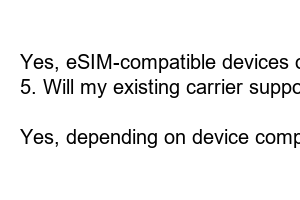유심 이심 차이
Title: Understanding the Difference between SIM Cards and eSIM Cards
Introduction:
In today’s digital era, staying connected has become paramount. Two key components enabling seamless communication are the traditional SIM card and the emerging eSIM card. While they serve the same purpose of connecting devices to cellular networks, there are significant differences between the two. In this blog post, we will explore these variances, providing you with a comprehensive understanding of SIM cards and eSIM cards.
1. What is a SIM Card?
A SIM card, short for Subscriber Identity Module card, is a small removable chip that stores essential information used to identify a subscriber on a mobile network. It provides authentication, allows access to voice and data services, and stores personal numbers and contacts. A traditional SIM card needs physical installation into a device.
2. What is an eSIM Card?
eSIM, or Embedded SIM, is a digital SIM technology that eliminates the need for a physical SIM card. Instead, it is embedded directly into a device during manufacturing. This programmable virtual SIM can be remotely activated, updated, and switched between mobile networks, making it incredibly convenient for users.
3. Connectivity and Flexibility:
While a standard SIM card is locked to a specific carrier or operator, an eSIM card offers flexible connectivity options. Users can switch carriers without physically changing the SIM card, making it particularly advantageous for frequent travelers or those requiring multiple network connections.
4. Device Compatibility:
Traditional SIM cards are compatible with most devices, including smartphones, tablets, routers, and more. On the other hand, eSIM cards are relatively new, and not all devices support this technology. However, with increasing adaptation, more manufacturers are introducing eSIM compatibility into their devices.
5. Capacity and Storage:
Standard SIM cards have limited storage capacity, supporting a finite amount of contact information and messages. eSIM cards, being digital, have virtually unlimited storage, enabling users to store additional data and supporting more extensive functionalities.
6. Security and New Features:
Both SIM cards and eSIM cards offer robust security features to protect subscriber information and prevent unauthorized usage. However, eSIM cards have the potential to offer enhanced security measures due to their ability to generate unique temporary identities for each network connection, decreasing the risk of identity theft or fraud.
Summary:
In conclusion, while both SIM cards and eSIM cards serve the purpose of connecting devices to cellular networks, they differ significantly in terms of installation, connectivity options, device compatibility, storage capacity, and security features. The eSIM card revolutionizes the way we connect, offering flexibility, remote management, and potentially enhanced security. As technology advances, eSIM cards are set to become more prevalent, empowering users with increased connectivity options and convenience.
FAQs (Frequently Asked Questions):
1. Can I convert my existing SIM card into an eSIM?
No, you cannot convert a physical SIM card into an eSIM. You will need a device that supports eSIM technology to use it.
2. Can I switch between multiple carriers using an eSIM?
Yes, with an eSIM, you can switch between multiple carriers without changing the physical SIM card. It offers greater flexibility in choosing and actively using multiple network connections.
3. Are eSIM cards more expensive than traditional SIM cards?
The cost of eSIM cards can vary depending on the device and carrier. In some cases, eSIM cards may be included in the device purchase price, while others might require a separate purchase or subscription.
4. Can I still use a traditional SIM card if I have an eSIM-compatible device?
Yes, eSIM-compatible devices often have a hybrid slot, allowing users to use either an eSIM or a traditional SIM card.
5. Will my existing carrier support eSIM technology?
Many major carriers around the world already support eSIM technology. It is best to check with your carrier or view their website to determine if eSIM activation is available.
6. Can I transfer my eSIM to a new device?
Yes, depending on device compatibility, you can transfer your eSIM to a new device. However, the process may vary between manufacturers and carriers, so it is recommended to seek guidance from your respective provider.

